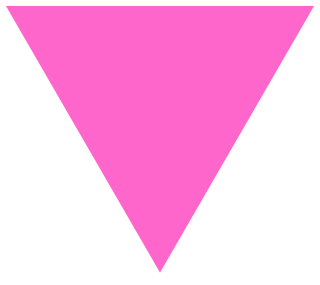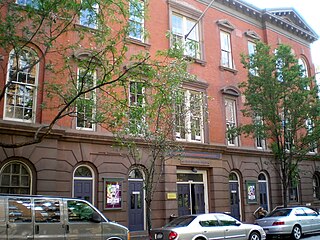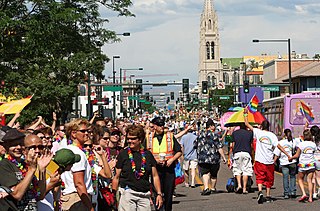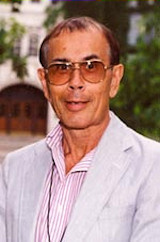Related Research Articles

A pink triangle has been a symbol for the LGBT community, initially intended as a badge of shame, but later reappropriated as a positive symbol of self-identity. In Nazi Germany in the 1930s and 1940s, it began as one of the Nazi concentration camp badges, distinguishing those imprisoned because they had been identified by authorities as gay men or trans women. In the 1970s, it was revived as a symbol of protest against homophobia, and has since been adopted by the larger LGBT community as a popular symbol of LGBT pride and the LGBT movements and queer liberation movements.
The Log Cabin Republicans (LCR) is an organization affiliated with the Republican Party which works to educate the LGBT+ community and Republicans about each other.

The Lesbian, Gay, Bisexual & Transgender Community Center, commonly called The Center, is a nonprofit organization serving the lesbian, gay, bisexual and transgender (LGBTQ) population of New York City and nearby communities.

PrideFest is an annual gay pride event held each June in Denver, honoring the culture and heritage of the lesbian, gay, bisexual, and transgender community in the State of Colorado. The first "Pride" event in Denver, known as Gay Pride Week, took place June, 1974 and included a "gay-in" in Cheesman Park attended by about fifty people. The first Gay Pride Parade took place in 1975 with approximately 200 people marching along sidewalks to the Civic Center Park unaware that they needed a permit. The first event resembling the present day Denver PrideFest occurred in 1976, the same year the local community center, now known as the Center on Colfax, was founded. The Center organizes and produces the festival and parade each year. The event currently consists of a two-day festival at Civic Center Park, the Pride 5K, and culminates with a parade along Colfax Avenue. Denver PrideFest now draws 525,000 guests annually, making it the third largest pride festival and seventh largest pride parade in the United States.

The Audre Lorde Project is a Brooklyn, New York–based organization for LGBTQ people of color. The organization concentrates on community organizing and radical nonviolent activism around progressive issues within New York City, especially relating to LGBTQ communities, AIDS and HIV activism, pro-immigrant activism, prison reform and organizing among youth of color. It is named for the lesbian-feminist poet and activist Audre Lorde and was founded in 1994.

James Willis Toy was a long-time American activist and a pioneer for LGBT rights in Michigan.
LGBTQ rights organizations are non-governmental civil rights, health, and community organizations that promote the civil and human rights and health of sexual minorities, and to improve the LGBTQ community.
The Maryland Coalition for Trans Equality (MCTE) is a coalition of organizations and individuals working to advance equal rights for transgender, transsexual, and gender non-conforming people in Maryland. Their stated goal is to achieve this "through shared leadership, decision-making processes, and resources". It is the largest coalition assembled in Maryland whose activities focus on advocacy and education with regard to transgender and gender non-conforming equality issues.

The David Bohnett Foundation is a private foundation that gives grants to organizations that focus on its core giving areas – primarily Los Angeles area programs and LGBT rights in the United States, as well as leadership initiatives and voter education, gun violence prevention, and animal language research. It was founded by David Bohnett in 1999. As of 2022, the foundation has donated $125 million to nonprofit organizations and initiatives.

The Tucson Gay Museum maintains an extensive collection of archival materials, artifacts and graphic arts relating to the history of LGBT people in the United States, with a focus on the LGBT communities of Tucson, Arizona and Phoenix, Arizona. It became a member of the Arizona LGBTQIA+ Archives in 2020.

Rea Carey is an American lesbian, gay, bisexual and transgender (LGBT) rights activist and served as the executive director of the National LGBTQ Task Force from 2008 to 2021. She previously served as the organization's deputy executive director and was the founding executive director of the National Youth Advocacy Coalition.

The LGBT community in Metro Detroit is centered in Ferndale, Michigan, as of 2007. As of 1997, many LGBT people live in Ferndale, Pleasant Ridge, and Royal Oak. Model D stated in 2007 that there are populations of gays and lesbians in some Detroit neighborhoods such as East English Village, Indian Village, Lafayette Park, and Woodbridge and that the concentration of gay bars in Detroit is "decentralized".
The Gay and Lesbian Labor Activists Network (GALLAN) is a non-profit organization of trade unionists founded in 1987 by Tess Ewing, Harneen Chernow, Susan Moir, Cheryl Schaffer, Nancy Marks, Gerry Thomas, Tom Barbara and Diane Fry and a few other members of Boston's LGBTQ community. GALLAN's main purpose was to support LGBTQ rights and oppose homophobia in the workforce, as well as push its unions to campaign for anti-discriminatory measures and benefits packages. GALLAN started as a series of potluck dinners and discussions, and later hosted events for the community in partnership with labor unions to campaign for LGBTQ rights in Massachusetts.
D.C.Black Pride is the first official black gay pride event in the United States and one of two officially recognized festivals for the African-American LGBT community. It is a program of the Center for Black Equity (CBE) and is also affiliated with the Capital Pride Alliance. DC Black Pride is held annually on Memorial Day weekend.
Austin, Texas, has one of the most prominent and active LGBT populations in the United States. Austin was acclaimed by The Advocate in 2012 as part of its Gayest Cities in America, and was recognized by Travel and Leisure as one of America's Best Cities for Gay Travel. Much of Austin's gay nightlife scene is clustered around 4th Street. LGBT activism groups Atticus Circle and Equality Texas are headquartered in Austin.
LGBT culture in St. Louis is characterized by a long history of progressive activism as well as racial divisions and the city/county divide. St. Louis city is relatively liberal with multiple gayborhoods and several LGBT organizations. In 2019, Realtor.com dubbed St. Louis the 8th most LGBT-friendly city. Due to hostile legislation at the state level, however, it has become common for LGBT residents to relocate to Illinois for better protections and healthcare access.
The Boston Alliance of Gay, Lesbian, Bisexual, and Transgender Youth (BAGLY) is a non-profit organization located in Boston that works to protect, expand, and raise awareness for the rights of gay, lesbian, bisexual, transgender, queer, and questioning youth (LGBTQ+). Founded by LGBTQ+ youth in 1980, it adopts a youth-led, adult-supported approach to better meet the varied needs of a wide demographic of LGBTQ+ youth in Greater Boston. BAGLY's stated goals are to create, sustain, and advocate for socially just and intersectional programs, policies, and services for the LGBTQ+ youth community, which they achieve through frequent community-based leadership development, health promotion, and social support programs.
The Gay Coalition of Denver (1972-1977) was a gay liberation organization founded in Denver, Colorado. GCD was central for the gay community, and offered services like doctor referrals, counseling, and a phone hotline. They led the City Council Revolt in October 1973, in which the Denver City Council repealed Denver laws that targeted the gay community.
References
- ↑ "About The Center on Colfax". The Center on Colfax.
- ↑ O'Donnell, Tim. "Denver's Center on Colfax Boosts the Preservation of Colorado's LGBTQ+ History". National Trust for Historic Preservation.
- 1 2 Bindel, Paul (December 16, 2015). "In the beginning..." Out Front Magazine.
- 1 2 Gerash, Gerald (June 3, 2016), "On the Shoulders of the Gay Coalition of Denver", in Nash, Phil (ed.), United We Stand: The Story of Unity and the Creation of the Center, Denver, Colorado: The Center, pp. 3-7.
- ↑ City and County of Denver Civil Action No. C37520, Gay Coalition of Denver et al. v. City and County of Denver et al., Complaint for Declaratory Judgment and Injunctive Relief, filed in District Court June 27, 1973.
- ↑ Parmenter, Cindy (October 4, 1974). "Pact May End Homosexual, Police Hassle". Denver Post. p. 44.
- 1 2 3 4 5 6 7 8 9 "History of The Center". The Center on Colfax.
- ↑ "The Center on Colfax". Denver Pride.
- ↑ "COLORADO AIDS PROJECT RECORDS". Denver Public Library.
- ↑ "Colorado Gay and Lesbian news". Brown University Library Catalog.
- ↑ "EQUALITY COLORADO RECORDS". Denver Public Library.
- 1 2 "Colorado Experience: LGBTQ". Youtube. Rocky Mountain PBS.
- ↑ "The Center Advancing LGBT Colorado--Sage of the Rockies". Denver Regional Council of Governments.
- ↑ "Colorado LGBTQ History Project". The Center on Colfax.
- ↑ Patterson, Denny (September 22, 2021). "The Center on Colfax Celebrates 45 Years". Out Front Magazine.